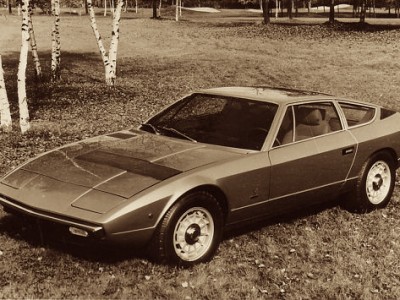Details
- JUST SOLD
- Dealer Location: Madrid
- Trans: Choose an item
- Fuel Type: Gas
- Ext color: blue celeste
- Int color: tan
Penned by the famous and very talented Giorgetto Giugiaro, the Ghibli was one of his earliest designs. Featuring Maserati’s wonderful quad-cam alloy V8, the car had excellent performance, but was also well-appointed and comfortable. While in production, it was Maserati’s flagship, and represented the last of the traditional front-engined cars before the mid-engined fad began. With just over 1,100 coupes constructed, they are rarer, and arguably better value, than Ferrari’s Daytona which are several multiples their value.
The Ghibli’s V8 employed dry-sump lubrication. As opposed to the traditional wet sump that stores oil in a pan beneath the engine, dry-sump systems use a separate reservoir to hold oil, from where it is pumped into the engine for lubrication and then recirculated back into the reservoir. This design, popular on racing cars of the era and even today used almost exclusively in high-performance applications, gave many advantages. First, and perhaps most important to the Ghibli’s menacing shape, was its allowance for an engine with as little vertical height as possible. With no need for an oil sump beneath the engine, the Ghibli’s motor could be lowered in the car’s frame to allow for a low center of gravity and, of course, the car’s mean, low hoodline. Dry-sump lubrication also prevented oil starvation and provided better oil cooling, making the Ghibli’s engine comfortable on any track.
The impressive V8 coupled to a ZF five-speed gearbox of equal quality. This team fed a limited-slip differential, which supplied power to the rear Campagnolo mags with ferocity. Though wire wheels were also available, the Campagnolos seemed a better choice with their light weight and nice design that complemented the Ghibli‘s shape.
Performance figures were staggering. From a standstill, the Ghibli could achieve 60mph in a scant 6.4 seconds. The quarter mile passed in 14.5 seconds. When the Ghibli SS was introduced in 1970 with an updated 4.9L V8 producing 335hp, this Maserati became capable of reaching incredible speeds. The Ghibli SS could reportedly exceed 280 kilometers per hour. Converted to a measurement we can fathom, that meant over 170mph. That type of speed was unreal in 1970, and it turned the Ghibli, which was named after a rapid wind, into a legend more than capable of living up to its label.
The Ghibli’s imposing posture was the work of one of Italy’s most prolific car designers, Giorgetto Giugiaro. The Ghia badge adorning the Ghibli’s body designated the design house for which Giugiaro was then working, Carrozzeria Ghia. Giugiaro had a hand in styling some of history’s best remembered cars, and the Ghibli’s shape continues to impress today.
Pop-up lights and the dry-sump allowed for a low hood and an imposing frontal aspect featuring a wide grille of black mesh with the trident standing proudly at its center. The windshield’s aggressive rake continued the theme, and it swept up to a low roof (the Ghibli stood just 45 inches tall). That roof was tilted towards the rear of the car, and it met the backlight seamlessly where it continued its downward slope to endow the car with a clean fastback shape. The rear was finished with a tight Kamm tail.
Not to leave anyone fooled by the sweeping lines and motorsport-inspired powertrain and drivetrain, the Ghibli’s sumptuous interior reminded that this really was a GT car. With a generous trunk and comfortable seats, the Ghibli was set to erase miles quickly on the open road.
Throughout its production run from 1967 to 1973, the Ghibli proved itself worthy of the trident badge. It was a well-engineered machine clothed in fine Italian style, and it is remembered today as one of the finest road-going Maseratis ever produced. A success for its parent company, 1,149 Ghibli coupes were produced along with 125 Spyders but only a “handful” of Ghibli SS coupes were produced (it is said that only 150 units) which are in these days the most desirable units. The relatively high production numbers once made Ghiblis easy to pick up for reasonable prices. Collectors are catching on, though, and values are on the rise. These stunning Maseratis are sure to be remembered as one of the company’s greatest achievements.
It is in need of restoration and partially dismantled but we are talking about a great project, with no signs of rust, fully matching numbers and complete to the 99%. The chassis is excellent, with its complete original interior, AC and wire wheels. All appear to be original. The wood rimmed steering wheel is in good shape, although there are small hairline cracks in the varnish. The switches and controls are in good condition throughout.
This is an excellent opportunity to acquire an interesting, rare, and attractive classic Italian sports car. This particular car spent its life in California and for almost 30 years had only one owner. Classic Maseratis from the 50′s and 60′s are highly appreciated, mainly the low production units. The Ghibli coupe Super Sport is a fine way to experience a world-class classic Italian sports car with a racing-derived motor, coachbuilt Italian bodywork (often considered Ghia’s best work), and genuine rarity with a “handful” of units produced with the more powerful 4.9 liter Super Sport engine. Although less appreciated than the Ghibli spyder, they continue to be undervalued, particularly compared to contemporary Ferraris, examples of which are now trading for well over $ 2 Mil.
This particular beauty, wearing the most beautiful original color combination (blue celeste with tan interior) is considered to become a classic car icon which we’re sure it’ll brake sale records in every auction. A similar car, fully rebuilt, is for sale in the UK at a very well reputed classic car dealer for 250.000 GBP (300.000 Euros)
We recommend the following videoclips:




